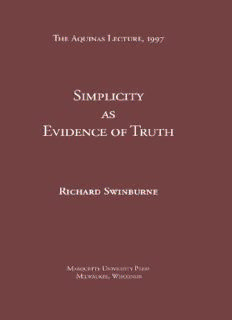
Simplicity As Evidence of Truth (Aquinas Lecture) PDF
Preview Simplicity As Evidence of Truth (Aquinas Lecture)
Simplicity as Evidence of Truth The Aquinas Lecture, 1997 Simplicity as Evidence of Truth Under the auspices of the Wisconsin-Alpha Chapter of Phi Sigma Tau by Richard Swinburne Library of Congress Cataloging-in-Publication Data Swinburne, Richard. Simplicity as evidence of truth / by Richard Swinburne. p. cm. — (The Aquinas lecture ; 1997) “Under the auspices of the Wisconsin-Alpha Chapter of Phi Sigma Tau.” Includes bibliographical references. ISBN 0-87462-164-X (cloth) 1. Explanation. 2. Simplicity (Philosophy) I. Title. II. Series. BD237.S85 1997 121'.6—dc21 96-51315 All rights reserved. No part of this publication may be reproduced, stored in a retrieval system, or transmitted in any form or by any means, electronic, mechanical, photocopying, recording or otherwise, without prior permission of the publisher. © 1997 Marquette University Press Second printing 2004 Printed in the United States of America Prefatory The Wisconsin-Alpha Chapter of Phi Sigma Tau, the International Honor Society for Philoso- phy at Marquette University, each year invites a scholar to deliver a lecture in honor of St. Thomas Aquinas. The 1997 Aquinas Lecture, Simplicity As Evi- dence of Truth, was delivered in the Tony and Lucille Weasler Auditorium on Sunday, March 2, 1997, by Richard G. Swinburne, the Nolloth Professor of the Philosophy of the Christian Religion at the Univer- sity of Oxford. Professor Swinburne was educated at the Uni- versity of Oxford where as an undergraduate he read for a B.A. in Philosophy, Politics, and Economics, which he received in 1957. He subsequently read for a B.Phil. in Philosophy, which he received in 1959 and for the Oxford Diploma in Theology, which he received in 1960. He was the Leverhulme Research Fellow in the History and Philosophy of Science at the University of Leeds (1961-1963). He was Lecturer in Philosophy at the University of Hull (1963-1972), Visiting Associate Professor of Phi- losophy at the University of Maryland (1969-1970), and Professor of Philosophy at the University of Keele (1972-1984). Since 1985 he has been the Nolloth Professor of the Philosophy of the Chris- tian Religion at the University of Oxford. He was elected a Fellow of the British Academy in 1992. Professor Swinburne has written Space and Time (1968), The Concept of Miracle (1971), An Intro- duction to Confirmation Theory (1973), a trilogy on the philosophy of theism: The Coherence of Theism (1977), The Existence of God (1979), and Faith and Reason (1981), The Evolution of the Soul (1986), three volumes of a projected tetralogy on the philosophy of Christian doctrine: Responsibility and Atonement (1989), Revelation: From Metaphor to Analogy (1991), and The Christian God (1994), in addition to Is There a God? (1996). He has also edited the following books: The Justification of Induction (1974), Space, Time and Causality (1983), and Miracles (1989), and is coauthor with Sydney Shoe- maker of Personal Identity (1984). In 1994 Profes- sor Swinburne was honored by many of his distin- guished colleagues with a festschrift entitled: Rea- son and the Christian Religion, to which he contrib- uted an essay, “Intellectual Autobiography.” Among his more than seventy-five scholarly articles are “The Argument from the Fine-Tuning of the Universe,” “Analytic/Synthetic,” “Thisness,” “Tensed Facts,” “The Objectivity of Morality,” “Necessary A Posteriori Truth,” “God and Time,” “The Beginning of Time and of the Universe.” To Professor Swinburne's distinguished list of publications, Phi Sigma Tau is pleased to add: Sim- plicity As Evidence of Truth. Simplicity as Evidence of Truth by Richard Swinburne Simplicity as Evidence of Truth I seek in this essay to show that—other things being equal—the simplest hypothesis proposed as an explanation of phenomena is more likely to be the true one than is any other available hypothesis, that its predictions are more likely to be true than are those of any other available hypothesis, and that it is an ultimate a priori epistemic principle that sim- plicity is evidence of truth. I. The Structure of Explanation Before arguing my main contentions, I need to make a number of (mostly) very familiar points about the nature of explanation. Talk of explana- tion in this essay is talk of causal explanation, talk of the factors operative in bringing about some event. ‘Explanation’ and cognate words can be used in strong or weak senses. In a strong sense an explana- tion of an event is a true explanation, a description of factors which made the event occur. In a weak sense an explanation is a purported explanation in
